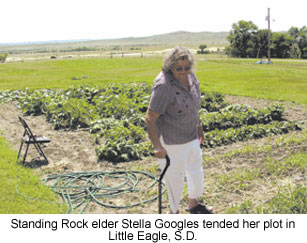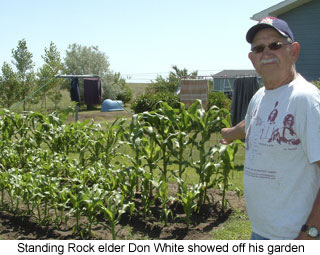 |
Canku Ota
|
 |
|
(Many Paths)
|
||
|
An Online Newsletter
Celebrating Native America
|
||
|
September 1, 2009 -
Volume 7 Number 9
|
||
|
|
||
|
Gardeners Fight Diabetes
With Homegrown Foods
|
||
|
by Stephanie Woodard
- Indian Country Today correspondent
|
||
|
credits: photos courtesy
Standing Rock Sioux Tribe Diabetes Program
|
|
CDC grant helps Standing Rock Sioux Tribe Native Gardens Project plant for a healthy future
“I said, ‘I’m going to go for it.’ What better way to find out what we need? And why wait? We’re on the front lines of the fight against diabetes.” Standing Rock’s gardening project is one of 17 tribal entities that received a grant of about $100,000 per year for five years from the Centers for Disease Control’s Native Diabetes Wellness Program. Skye, who has been gardening on Standing Rock since 2002, called on the Rapid City office of National Relief Charities, which has self-sufficiency oriented partnerships on reservations nationwide. Two staffers arrived with tractors to till 120 family gardens, in sizes ranging up to 30 feet by 50 feet, throughout Standing Rock’s 2.3 million acres in North and South Dakota, along with a one-acre community garden in the reservation’s Porcupine District. Skye and his wife, Linda, built additional easy to tend 4-by-8-foot raised bed box gardens for elders.
Skye also holds public meetings so gardeners can report problems. Mainly, they have requested fencing to keep out animals and mowing around the beds to control grasshoppers. According to John Buckley, diabetes program director, the gardening opportunity was announced to tribal members at reservation district meetings and through media outlets such as the local newspaper and radio station. There was no problem finding participants.
Tribal members of all ages became involved in both gardening and collecting of traditional gathered foods. Charmayne Eagleman, a Standing Rock elder from Wakpala, South Dakota, recently took children from a local Boys & Girls Club to harvest tinpsila, or prairie turnips, a long-time Lakota/Dakota favorite. “We hiked a mile south of Porcupine,” Skye said. “The kids were so excited to learn to identify the turnips and tag them with red ribbons for the diggers. I got assigned to be a digger. On the way back, we rested in the shade of a tree, and Charmayne told us stories about the turnips. She said they can up and move when you look away, which is why you must tag them.” Upcoming expeditions will collect wild plums, chokecherries and buffalo berries. When the tinpsila gatherers returned to Porcupine, the kids asked Skye to teach them to set up a tipi. “Sure thing,” he told them; if they did some weeding in the community garden first. Weeds are the bane of the organic gardener, according to Skye. “You can hand pull them in a family-size plot, but eventually I’d like to see an organic operation here that’s big enough to feed the reservation. You can’t hand weed big fields, though. So, I need to explore the latest agricultural techniques, such as cover crops that become mulch into which you plant food crops. Exciting new ideas are coming out of places like the Rodale Institute.” So far, it’s been a good, if delayed, growing season in the Dakotas. Snow flurries lasted into June, but once they were over, the abundant moisture the Northern Plains received in spring ended a nine-year drought and helped Standing Rock’s gardens take off.
Once the harvest starts coming in, Long Soldier Farmers Market will benefit from a concurrent grant from the U.S. Department of Agriculture that provided Standing Rock elders with about $90 each in vouchers for fresh fruits and vegetables. Skye keeps an eye out for potential vendors in addition to the gardeners he is monitoring for the grant. “If I’m driving along and happen to spot a plot, I pull over and invite the owner, Native or non-Native, to sell at the market.” The season will be capped by a late-September harvest festival and wacipi that will celebrate foodways past and present. “It’s gratifying to know that something our grandparents did to survive helps us to live in a good, healthy way today,” Buckley said. |
|
|
||
|
|
||
| Canku Ota is a free Newsletter celebrating Native America, its traditions and accomplishments . We do not provide subscriber or visitor names to anyone. Some articles presented in Canku Ota may contain copyright material. We have received appropriate permissions for republishing any articles. Material appearing here is distributed without profit or monetary gain to those who have expressed an interest. This is in accordance with Title 17 U.S.C. Section 107. | ||
|
Canku Ota is a copyright ©
2000, 2001, 2002, 2003, 2004, 2005, 2006, 2007, 2008, 2009 of Vicki
Barry and Paul Barry.
|
||
 |
 |
|
|
The "Canku
Ota - A Newsletter Celebrating Native America" web site and
its design is the
|
||
|
Copyright ©
1999, 2000, 2001, 2002, 2003, 2004, 2005,
2006, 2007, 2008, 2009 of Paul
C. Barry.
|
||
|
All Rights Reserved.
|
||
 FORT
YATES, N.D. – “This year was meant to be a planning
period for our new gardens grant, but we’re in full swing,”
said Aubrey Skye, Hunkpapa Lakota, Native Gardens Project coordinator
for the Standing Rock Sioux Tribe Diabetes Program.
FORT
YATES, N.D. – “This year was meant to be a planning
period for our new gardens grant, but we’re in full swing,”
said Aubrey Skye, Hunkpapa Lakota, Native Gardens Project coordinator
for the Standing Rock Sioux Tribe Diabetes Program. If
an elder is frail, Skye cares for his or her garden himself, on
top of running an operation that encompasses the weekly Long Soldier
Farmers Market in the reservation’s capital, Fort Yates, as
well as herb walks, forays to collect traditional Lakota/Dakota
gathered foods and collaborations with groups including Sitting
Bull College, Standing Rock Farms (the tribe’s commercial agriculture
operation), state fish and game departments, state extension offices,
Slow Food USA and the North Dakota Farmers Market and Growers Association.
If
an elder is frail, Skye cares for his or her garden himself, on
top of running an operation that encompasses the weekly Long Soldier
Farmers Market in the reservation’s capital, Fort Yates, as
well as herb walks, forays to collect traditional Lakota/Dakota
gathered foods and collaborations with groups including Sitting
Bull College, Standing Rock Farms (the tribe’s commercial agriculture
operation), state fish and game departments, state extension offices,
Slow Food USA and the North Dakota Farmers Market and Growers Association. “People
here relate to gardening. We’ve gardened since we were put
on reservations, and we know it means good food and good exercise.
That’s so important now that diabetes is increasing, along
with today’s increased availability of so-called junk and fast
foods.”
“People
here relate to gardening. We’ve gardened since we were put
on reservations, and we know it means good food and good exercise.
That’s so important now that diabetes is increasing, along
with today’s increased availability of so-called junk and fast
foods.” By
the third week of July, corn was thigh-high; squash was in blossom;
and beans, tomatoes, chili peppers, cucumbers and sunflowers were
flourishing. Most of the seed for the crops came from packets distributed
by National Relief Council.
By
the third week of July, corn was thigh-high; squash was in blossom;
and beans, tomatoes, chili peppers, cucumbers and sunflowers were
flourishing. Most of the seed for the crops came from packets distributed
by National Relief Council.